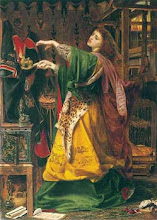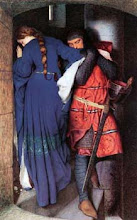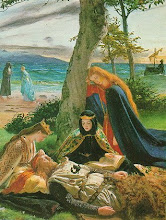By Ian JohnstonWednesday, 6 August 2008
The Picts have long been regarded as enigmatic savages who fought off Rome's legions before mysteriously disappearing from history, wild tribesmen who refused to sacrifice their freedom in exchange for the benefits of civilisation. But far from the primitive warriors of popular imagination, they actually built a highly sophisticated culture in northern Scotland in the latter half of the first millennium AD, which surpassed their Anglo-Saxon rivals in many respects.
A study of one the most important archaeological discoveries in Scotland for 30 years, a Pictish monastery at Portmahomack on the Tarbat peninsula in Easter Ross, has found that they were capable of great art, learning and the use of complex architectural principles.
The monastery – an enclosure centred on a church thought to have housed about 150 monks and workers – was similar to St Columba's religious centre at Iona and there is evidence they would have made gospel books similar to the Book of Kells and religious artefacts such as chalices to supply numerous "daughter monasteries" .
And, in a discovery described as "astonishing, mind-blowing" by architectural historians, it appears that the people who built the monastery did so using the proportions of "the Golden Section", or "Divine Proportion" as it became known during the Renaissance hundreds of years later. This ratio of dimensions, 1.618 to one, appears in nature, such as in the spiral of seashells, and the faces of people considered beautiful, such as Marilyn Monroe. It can be seen in Notre Dame Cathedral in Paris, the Alhambra palace of Granada in Spain, the Acropolis in Athens and the Egyptian Pyramids, but was thought to have been too advanced for the Picts.
"The Picts have always been an attractive lost people, they are one of the most interesting lost peoples of Europe," said Martin Carver, a professor of archaeology at York University who has worked on the site since the mid-1990s, and recently written a book detailing the findings. "The big question is what happened to them and did they ever really make a kingdom of their own."
The answer to the latter question seems an emphatic yes, based on the findings at Portmahomack, which is remote today but would have once been a key point on sea routes in the North Sea. "They would have been dreaming of a New Rome and a new world connected by water rather than Roman roads," said Professor Carver. "They were the most extraordinary artists. They could draw a wolf, a salmon, an eagle on a piece of stone with a single line and produce a beautiful naturalistic drawing. Nothing as good as this is found between Portmahomack and Rome. Even the Anglo-Saxons didn't do stone-carving as well as the Picts did. Not until the post-Renaissance were people able to get across the character of animals just like that."
In addition to stone carving, the archaeologists found evidence that vellum, chalices and other religious artefacts were being made at the site on a considerable scale. Vellum, a form of paper made from animal skin, would have been used to make highly decorative gospel books. The cemetery, containing graves of middle-aged and elderly men almost exclusively, and a piece of stone bearing a tantalisingly incomplete inscription provided other key clues as to the Christian nature of the site.
"The most important piece had a Latin inscription. That's as common as muck in the Mediterranean, but extremely rare in Scotland," said Professor Carver, who previously led research into the Anglo-Saxon burial mound at Sutton Hoo, Suffolk. "It says 'This is the cross of Christ in memory of Reo...' and the rest is broken away. Unfortunately the key bit, the name of the person, is missing. It means there's someone around there who knows how to write in the eighth century. That itself is a revelation."
A Pictish wall, which is believed to have formed part of the original monastery's church, was discovered in the basement of the derelict church on the site, which has now been turned into a visitor centre. But it was the dimensions of another structure within the complex, the "Smith's Hall", that attracted particular attention as it was made with "a startling symmetry offering us more than just competence in construction" .
A detailed study was made of the horse-shoe shaped building, searching for the unit of measurement used by the Picts. Professor Carver said a "Tarbat foot" of 12-and-a-half inches seemed to have been the standard measure used to make hall and other parts of the monastery. He also found the ratios of lengths of different walls and bays inside the window conformed to the architectural principle called the Golden Section. "The Golden Section, together with its inverse, the Golden Number, 1.618, has been valued by artists for millennia ... and it is a true delight to observe it among their architects," he said. "It shows the importance of symbol and worship in everything done in the service of the Christian God.
"There is something rather intriguing in the learnt character of them. This is a building put up to house metal workers. It's the idea they were all possessed of the same kind of knowledge and all trying to serve it."
Jean Gowans, who recently retired as chairman of the Architectural Heritage Society of Scotland, said the idea the Picts had been using the Golden Section was "wonderful, astonishing" .
"It really is absolutely fascinating. It's mind-blowing stuff," she said. "This is staggering to hear, but I'm not totally surprised. I think they were pretty sophisticated, when you think of all the Pictish stones and the wonderful carvings that they made, a lot more sophisticated than perhaps they are given credit for in public perception."
The monastery at Portmahomack suffered a major fire in the ninth century and several stone sculptures were smashed, suggesting it was sacked by an invading force, likely to be Vikings intent on expanding their territories in northern Scotland. The site continued to be occupied but at this point evidence of a monastic settlement disappears.
However, the shared religion of the Picts and Scots may have helped them unite against a common enemy, ultimately creating the kingdom of Scotland. "There was a war as important as Alfred's against the Danes [in England] and the Picts got really battered. In the Annals of Ulster, there are records of battles where the flower of Pictish aristocracy is killed," Professor Carver said.
"Portmahomack got burnt down pretty definitively round about 820. The idea is they were under new masters. It could be the Norse or the Men of Moray, MacBeth and his family. I think Portmahomack was captured by the Men of Moray. The Norse wanted it badly but they didn't get it. There is no Norse material there. There was no more vellum-making and sculpture and it stopped being a monastery. In the ninth to 11th centuries, they are making metal work, but that's the real Dark Age."
Portmahomack: Monastery of the Picts is published by Edinburgh University Press
Tribes that resisted the Romans
Picts was the name which the Romans gave to a confederation of tribes living beyond the reach of their empire, north of the Forth and Clyde.
The name makes its first known appearance in the works of a third-century orator, Eumenius, and is assumed to come from the Latin word pingere, "to paint", suggesting they painted or tattooed their bodies.
But what name they called themselves, or what language they spoke, we do not know.
One thing that puzzled outsiders is that they were the last people on these islands to trace their lineage through their mothers. The Venerable Bede, writing in 731, said that the Picts had come from mainland Europe,presumably Scandinavia, to northern Ireland to ask for land, but the Irish sent them on to Scotland.
Hence a myth that the Picts were given Irish wives, on condition that they became matrilineal.
Other wild stories included that they were dark-skinned pygmies who hid in holes in the ground during the afternoon, but had magical powers at night.
Probably they were a coalition of indigenous tribes brought together by the Roman threat.
In Bede's lifetime, the Picts were defeated in war by the Northumbrians and converted to Roman Christianity.
Andy McSmith







































